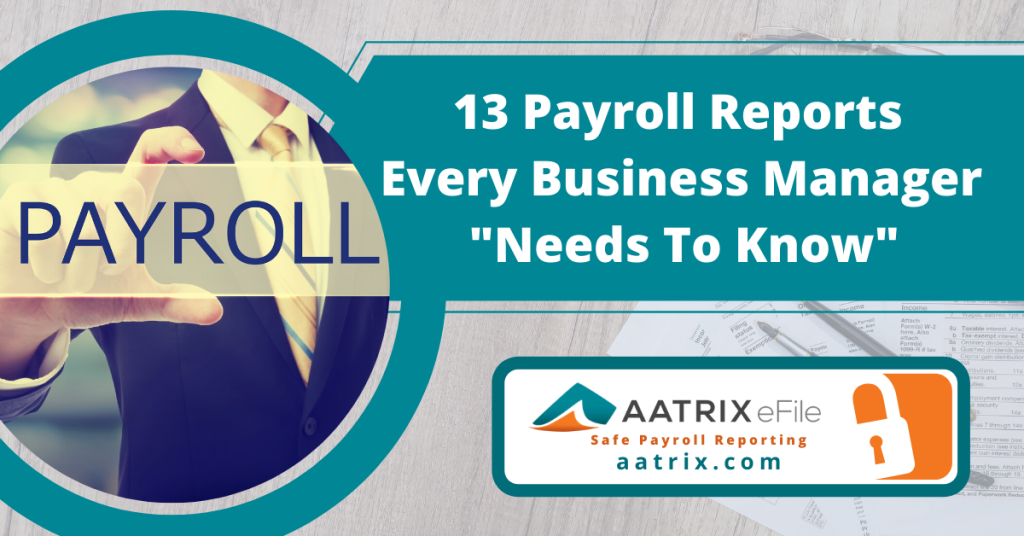Payroll Reports are critical when it comes to knowing your overall labor costs and profit margin.
Optimizing your labor costs, staying on budget are key to manage your business better.

What Are Payroll Reports?
Payroll reports are basically digital and paper form documents which contain calculations pertaining to:
General Payroll Reporting Information:
- Employee’s full name
- Social Security Number
- Complete address
- Birthdate (if younger than 19)
- Sex
- Occupation
- Offer letter (signed by you and the employee)
Time Related Payroll Reports Information:
- Time and day when work week begins
- Time and attendance records
- Total hours worked each day
- Total hours worked each work week
Pay Related Payroll Reporting Information:
- Pay rate you pay the employee
- Regular pay rate
- Total straight-time daily earnings
- Total overtime hours worked for the work week
- Additions to wages (e.g.,. bonus pay etc)
- Expense reimbursement forms
- Pay raise documentation
- Payroll advance documentation
- Payroll deductions (e.g., employee benefits)
- IRS Form W-4
- Income withholding orders
- Pay records
- Date wages are paid
- Time off history
- Remaining time off
- Direct deposit authorization
- IRS Form W-2
You can produce and or run payroll reports to give insight on any aspect of employees labor.
There are quite a few standard payroll reports required by your local, state and federal governments. Every business manager will need to know what payroll reports that are required.
When Should You Produce Payroll Reports

Monthly Payroll Reports
Some states require that you file certain payroll reports monthly. You will need to check with your state governments to determine what you are required to report, where to send it and what the deadline dates are.
Quarterly Payroll Reports
Most state governments and the IRS (Internal Revenue Service) require that you submit certain payroll reports. Quarterly payroll reports usually deal with income, Social Security, workers compensation, Medicare taxes and unemployment.
Annual Payroll Reports
Businesses are required to produce and submit several payroll reports at the end of each year. To accurately complete and submit your year-end federal, state and local payroll taxes these payroll reports are necessary!
Run Payroll Reports Anytime
Customized payroll reports are often run monthly by many businesses. You can run payroll reports just about anytime, even weekly. Weekly payroll reports help businesses watch and to be able to keep a handle on one of the company’s biggest expenses.
The Types Of Payroll Reports

1. Business Specific Payroll Reports
Many businesses will run business specific payroll reports unique to them based on their specific needs to make sure they are staying on budget or to check for other needs based on many business specific variables. There are many examples of business specific payroll reports.
18 Types of business specific payroll reports:
- Paid Time Off
- Overtime
- Payroll Compensation Analysis
- Payroll Register
- Total Payments
- Total hours worked
- Pay Type
- Time Clock
- Salary Analysis
- Wage and Tax Summary Report
- Tax Liability Report
- Tax Payment Report
- Employee Details Report
- Deductions and Compensation Report
- Payroll Summary Report
- Payroll Detail Report
- Labor Distribution Report
- History Summary Report
All these business specific payroll reports can be very beneficial and essential to business success. There may be a few more reports needed depending on your company’s needs.
2. Local Payroll Reports
Local payroll reports will and can vary depending on where your business locations are. Each local government may have mandatory payroll reporting requirements. Employers in some cities may be required to report certain payroll reports on a monthly or quarterly basis. Please check with your local government to see what your local payroll reporting obligations are.
3. State Payroll Reports
There are a few states that do not require businesses to file state income tax payroll reports.
The states that DO NOT REQUIRE state income tax reporting:
- Alaska
- Florida
- Nevada
- New Hampshire*
- South Dakota
- Tennessee*
- Texas
- Washington
- Wyoming
*Impose a state tax on “Dividends and Interest” only.
NOTE: These states do however require you to file “New Hire and Unemployment” reporting.
All other states have a personal income tax. Reciprocal agreements between states may come into play when you have multi-state employment withholding situations. Some states have disability programs which impose payroll tax responsibilities.
How to file your state payroll tax responsibilities?
Most all states allow businesses to file state payroll taxes similar to the way you file federal taxes to determine state income tax withholding amounts. Many states have exemption certificate forms for withholding purposes.
4. Federal Payroll Reports

Being an employer, your payroll obligations do not end after you distribute paychecks to your employees. The federal government needs you to file your federal payroll reports. Filing your payroll tax reports late can result in fines and penalties. Familiarize yourself with the different types of federal payroll reports.
5. Federal Payroll Report IRS Form 941
IRS Form 941 is used to report the amount of federal income tax, Medicare and Social Security you withheld from your employees’ paychecks along with the wages earned.
IRS Form 941 must be filed quarterly (every 3 months) and is due by the last day of the following month.
Form 941 is based on the calendar year, calendar year quarters end on:
- March 31st
- June 30th
- September 30th
- December 31st
The IRS Form 941 filing deadline dates:
- April, 30th
- July, 31st
- October 31st
- January 31st
6. Federal Payroll Report IRS Form 944
The Internal Revenue Service allows certain businesses that have smaller payroll taxes the ability to only file an annual return rather than quarterly. The IRS Form 944 serves the exact same purpose as the 941. You need to file IRS Form 944 by January 31st for the previous year. You will not need to file IRS Form 941 if you qualify to file IRS Form 944.
7. Federal Payroll Report IRS Form 940
As of 2012 an employer you are responsible for making federal unemployment tax contributions on the first $7,000 earned by each employee. IRS Form 940 is a payroll report that a business submits annually. Federal Unemployment Tax (FUTA) does not come out of the employees’ paychecks, FUTA is paid solely by your business.
IRS Form 940 is due January 31st for the preceding year ending December 31st.
8. Federal Payroll Report IRS Form 943
IRS Form 943 is for employers who paid wages to agricultural employees that are subject to income tax, Social Security or Medicare withholding must use this payroll report.
An employer is subject to withholding on wages if:
- You have paid and employee cash wages of $150 or more in the year for farm work, or
- Total wages (cash and non-cash) you pay all farm workers in the year is $2,500.
There are some exceptions for hand-harvest workers you pay less than $150 during the year.
See “ Form 943 Exceptions” here.
You must file your IRS Form 943 by January 31st of the year after you paid the wages.
9. Federal IRS Form W-2
IRS Form W-2 is an annual summary payroll report of an employees’ gross pay for the year. Form W-2 indicates the amount of dollars withheld for, local, state and federal deductions. Form W-2 will also show the dollar amount withheld for Medicare and Social Security and other miscellaneous items listed on the W-2 Form.
You must furnish a IRS Form W-2 to each employee for the previous year no later than January 31st.
You have until January 31st to provide the Social Security Administration with their copies.
10. Federal IRS Form W-3
IRS Form W-3 is a cover form that recaps certain totals from the IRS Form W-2 forms you are including when you file to the Social Security Administration. You must include a separate IRS Form W-3 for each batch of IRS Form W-2’s you send to the Social Security Administration.
IRS Form W-3 due dates correspond to the due dates for your W-2 forms.
11. Federal IRS Form 1099-NEC, Non Employee Compensation
IRS Form 1099-NEC is what you will now be used for non employee compensation.
The PATH Act, P.L. 114-113, Div. Q, sec. 201, brought the due date for filing Form 1099 that includes non-employee compensation (NEC) from February 28th to January 31st and eliminated the automatic 30-day extension for forms that include NEC. Beginning with the tax year of 2020, use Form 1099-NEC to report non-employee compensation. Always check the IRS website for clarification here.
12. Federal IRS Form 1099
IRS Form 1099-MISC, Miscellaneous Income Payroll Report is for each person to whom you have paid the following during the year:
- At least $10 in royalties or broker payments in lieu of dividends or tax-exempt interest.
- At least $600 in:
- Rents.
- Services performed by someone who is not your employee.
- Prizes and awards.
- Other income payments.
- Medical and health care payments.
- Crop insurance proceeds.
- Cash payments for fish (or other aquatic life) you purchase from anyone engaged in the trade or business of catching fish.
- Generally, the cash paid from a notional principal contract to an individual, partnership, or estate.
- Payments to an attorney.
- Any fishing boat proceeds.
In addition, use Form 1099-MISC to report that you made direct sales of at least $5,000 of consumer products to a buyer for resale anywhere other than a permanent retail establishment.
13. Federal IRS Form 7200
IRS Form 7200 is a new form for employers to use to obtain advance payments of three tax credits that were created to help businesses cope with the coronavirus pandemic.
- Qualified sick leave
- Family leave wages
- Employee retention credit
Employers may file new Form 7200, Advance Payment of Employer Credits Due to COVID-19, to obtain advances of employment taxes that are refundable as a result of the new tax credits.
Employers can file the form for advance credits anticipated for a quarter at any time before the end of the month following the quarter in which the employer paid the qualified wages. Employers are permitted to file Form 7200 several times during each quarter.
Form 7200 is used to request an advance payment of the tax credits for qualified Sick Leave wages, Family Leave wages, and the Employee Retention credit that you will claim on the following federal forms.
- Form 941, 941-PR, 941-SS
- Form 943, 943-PR
- Form 944, 944 (SP)
- Form CT-1
Employers should not file Form 7200 after they file any of these forms.
Some accounting softwares have most all tax and payroll reporting functions built into their software. Many simplify this process and can save a lot of time and money when filing state and federal taxes. A lot of businesses use Aatrix Software’s free uploader tool which can take all the guesswork out of your W-2, 1099 and 1095 reporting and filing.
Our customers says it best, see why over 300,000 businesses use Aatrix Software
To ease in your year-end payroll reporting, consider using our FREE Software.
